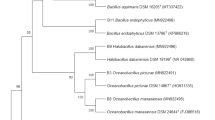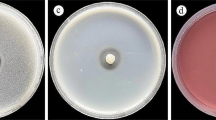Abstract
The siderophore production of various isolates of Phialocephala fortinii was assessed quantitatively as well as qualitatively in batch assays under pure culture conditions at different pH values and iron(III) concentrations. We found a distinct effect of both of these parameters on siderophore synthesis and as well as on fungal growth. In comparative analyses of two of the isolates, maximum siderophore production was found at a pH in the range of pH 4.0 to 4.5 while, under the experimental conditions employed, the optimal concentration of ferric iron was determined to be between 20–40 μg iron (III) l−1 (0.36–0.72 μM, respectively). HPLC analysis of the culture filtrate of most of the isolates of P. fortinii revealed the excretion of ferricrocin as main hydroxamate siderophore, followed by ferrirubin and ferrichrome C. The pattern of release of these three substances proved to be dependent on pH and iron(III) concentration of the culture medium, and to be specific for each isolate under investigation.
Similar content being viewed by others
References
Ahlich Schlegel K. 1997 Vorkommen und Charakterisierung von dunklen, septierten Hyphomyceten (DSH) in Gehölzwurzeln. Thesis, No. 12176, ETH Zürich, Switzerland.
Ahlich K, Sieber TN. 1996 The profusion of dark septate endophytic fungi in non-ectomycorrhizal fine roots of forest trees and shrubs. New Phytol 132, 259–270.
Archibald F. 1983 Lactobacillus plantarum, an organism not requiring iron. FEMS Lett 19, 29–32.
Currah RS, Sigler L, Hambleton S. 1987 New records and new taxa of fungi from the mycorrhizae of terrestrial orchids of Alberta. Can J Bot 65, 2473–2482.
Currah RS, Smreciu EA, Hambleton S. 1990 Mycorrhizae and mycorrhizal fungi of boreal species of Platanthera and Coeloglossum (Orchidaceae). Can J Bot 68, 1171–1181.
Currah RS, Tsuneda A. 1993. Vegetative and reproductive morphology of Phialocephala fortinii (Hyphomycetes, Mycelium radicis atrovirens) in culture. Trans Mycol Soc Japan 34, 345–356.
Currah RS, Tsuneda A, Murakami S. 1993 Morphology and ecology of Phialocephala fortinii in roots of Rhododendron brachycarpum. Can J Bot 71, 1639–1644.
Fernando AA, Currah RS. 1996 A comparative study of the effects of the root endophytes Leptodontium orchidicola and Phialocephala fortinii (Fungi imperfecti) on the growth of some subalpine plants in culture. Can J Bot 74, 1071–1078.
Fett JP, LeVier K, Guerinot ML. (1998) Soil microorganisms and iron uptake by higher plants. In: Sigel A, Sigel H. eds. Metal Ions in Biological Systems. New York: Dekker: 187–214.
George E, Römheld V, Marschner H. 1994 Contribution of mycorrhizal fungi to micronutrient uptake by plants. In: Manthey JA, Crowley DE, Luster DG. eds. Biochemistry of Metal Micronutrients in the Rhizosphere. Boca Raton, FL: Lewis Publishers: 93–109.
Haselwandter K. 1987 Mycorrhizal infection and its possible ecological significance in climatically and nutritionally stressed alpine plant communities. Angewandte Botanik 61, 107–114.
Haselwandter K. 1995 Mycorrhizal fungi: Siderophore production. Crit Rev Biotechnol 15, 287–291.
Haselwandter K, Read DJ. 1980 Fungal associations of roots of dominant and sub-dominant plants in high-alpine vegetation systems with special reference to mycorrhiza. Oecologia (Berl.) 45, 57–62.
Haselwandter K, Read DJ. 1982 The significance of a root-fungus association in two Carex species of high-alpine plant communities. Oecologia (Berl.) 53, 352–354.
Haselwandter K, Winkelmann G. 1998. Identification and characterization of siderophores of mycorrhizal fungi. In Varma A, ed. Mycorrhiza Manual Berlin: Springer-Verlag; 243–254.
Haselwandter K, Dobernigg B, Beck W, Jung G, Cansier A, Winkelmann G. 1992 Isolation and identification of hydroxamate siderophores of ericoid mycorrhizal fungi. BioMetals 5, 51–56.
Holdenrieder O, Sieber TN. 1992 Fungal associations of serially washed healthy non-mycorrhizal roots of Picea abies. Mycol Res 96, 151–156.
Jumpponen AM, Mattson KG, Trappe JM. 1998 Mycorrhizal functioning of Phialocephala fortinii with Pinus contorta on glacier forefront soil: interactions with soil nitrogen and organic matter. Mycorrhiza 7, 261–265.
Jumpponen AM, Trappe JM. 1998 Dark, septate endophytes: a review of facultative biotrophic root-colonizing fungi. New Phytol 140, 295–310.
Konetschny-Rapp S, Huschka H-G, Winkelmann G, Jung G. 1988 High-performance liquid chromatography of siderophores from fungi. Biol Metals 1, 9–17.
Matzanke BF. 1994 Iron storage in fungi. In: Winkelmann G, Winge DR. eds. Metal Ions in Fungi New York: Marcel Dekker, Inc.: 179–214.
Marschner H. 1995 Mineral Nutrition of Higher Plants. London: Academic Press.
Melin E. 1922 On the mycorrhizas of Pinus sylvestris L. and Picea abies Karst. A preliminary note. J Ecol 9, 254–257.
Neilands JB. 1972 Evolution of biological iron binding centers. Struct Bonding 11, 145–170.
Neilands JB. 1993 Perspectives in biochemistry and biophysics-Siderophores. Arch Biochem Biophys 302, 1–3.
Perrin DD, Dempsey B. 1974 Buffers for pH and Metal Ion Control, London: Chapman and Hall.
Read DJ. 1991 Mycorrhizas in ecosystems. Experientia 47, 376–391.
Read DJ, Haselwandter K. 1981 Observations on the mycorrhizal status of some alpine plant communities. New Phytol 88, 341–352.
Schwyn B, Neilands JB. 1987 Universal chemical assay for the detection and determination of siderophores. Anal Biochem 160, 47–56.
Smith SE, Read DJ. 1997 Mycorrhizal Symbiosis. San Diego: Academic Press.
Stoyke G, Currah RS. 1991 Endophytic fungi from the mycorrhizae of alpine ericoid plants. Can J Bot 69, 347–352.
Summerbell RC. 1989 Microfungi associated with the mycorrhizal mantle and adjacent microhabitats within the rhizosphere of black spruce. Can J Bot 67, 1085–1095.
Szaniszlo PJ, Powell PE, Reid CPP, Cline GR. 1981 Production of hydroxamate siderophore iron chelators by ectomycorrhizal fungi. Mycologia 73, 1158–1174.
Wang CJK, Wilcox HE. 1985 New species of ectendomycorrhizal and pseudomycorrhizal fungi: Phialophora finlandia, Chloridium paucisporum, and Phialocephala fortinii. Mycologia 77, 951–958.
Wilcox HE, Wang CJK. 1987 Mycorrhizal and pathological associations of dematiaceous fungi in roots of 7-month-old tree seedlings. Can J Forestry Res 17, 884–899.
Winkelmann G, Drechsel H. 1997 Microbial siderophores. In: Rehm H-J, Reed G. eds. Biotechnology, Vol. 7, Weinheim: VCH Verlagsgesellschaft mbH: 200–246.
Winkelmann G, Huschka H-G. 1987 Molecular recognition and transport of siderophores in fungi. In Winkelmann G. eds. Iron Transport in Microbes, Plants and Animals van der Helm D, Neilands J.B. Weinheim: VCH Verlagsgesellschaft mbH: 317–336.
Author information
Authors and Affiliations
Rights and permissions
About this article
Cite this article
Bartholdy, B., Berreck, M. & Haselwandter, K. Hydroxamate siderophore synthesis by Phialocephala fortinii, a typical dark septate fungal root endophyte. Biometals 14, 33–42 (2001). https://doi.org/10.1023/A:1016687021803
Issue Date:
DOI: https://doi.org/10.1023/A:1016687021803




